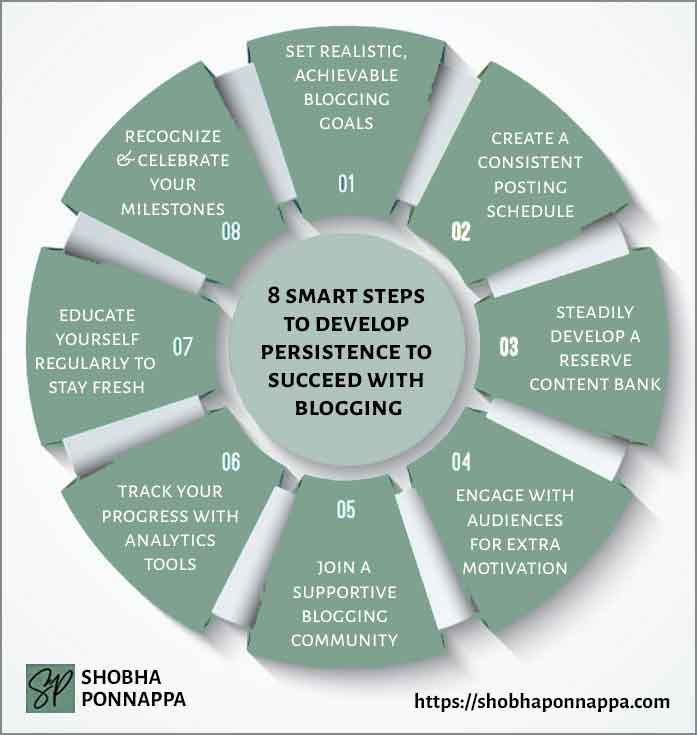
Bloggers face the twin challenges of creating engaging content and maintaining momentum in a saturated market.
The key to overcoming these obstacles lies not just in talent or inspiration, but in the often-overlooked virtue of persistence. And as the adage explains, persistence always pays off in the end.
To thrive and stand out with persistent blogging, it’s essential to blend time-tested methods with innovative strategies.
Embracing both conventional wisdom and unconventional tactics ensures a comprehensive approach to problem-solving. This enables bloggers to navigate the highs and lows of content creation while continually evolving and capturing their audience’s attention.
Persistence is the bedrock of blogging success – because of the inherently challenging nature of establishing and growing a digital presence in a crowded and ever-changing landscape.
This steadfastness is crucial for several reasons: it drives the continuous generation of content, essential for keeping an audience engaged and attracting new readers; it fuels the determination to push through periods of low engagement or writer’s block, common hurdles in any blogger’s journey; it underpins the resilience needed to adapt to shifting SEO trends and platform algorithms, ensuring that a blog remains visible and relevant.
Further, persistence supports the iterative process of refining blogging strategies based on feedback and analytics, allowing for the gradual improvement of content quality and audience targeting.
In essence, while creativity sparks initial interest, persistence builds a loyal audience, fosters trust, and ultimately carves out a niche in the vast digital ecosystem, making it an indispensable trait for anyone serious about achieving blogging success.
Embracing both proven and unusual ideas is key to developing blogging persistence, a philosophy that aligns with my “Unusual By Strategy” forte. This approach underscores the importance of blending traditional blogging strategies with innovative, less conventional methods to foster resilience and creativity.
For instance, while setting realistic goals and maintaining a consistent posting schedule are time-honored tactics for building persistence, integrating unconventional practices like engaging in cross-disciplinary research or adopting gamification elements to content creation can invigorate your blogging routine.
Such a mix not only helps in overcoming the monotony that sometimes accompanies long-term blogging but also sparks new ways of thinking and reaching your audience.
This deliberate fusion encourages continuous learning and adaptation, crucial for staying relevant in the dynamic digital landscape. It’s this unique blend of the conventional and the offbeat that can propel bloggers towards sustained success through persistence that’s creatively nurtured.
Leveraging my 40+ years’ experience as a Brand Content Strategist with a penchant for the unusual, I have crafted 8 ideas that blend time-tested approaches with innovative twists to enhance persistence in blogging.
These strategies not only embody the fundamental principles of consistency, engagement, and continuous learning but also incorporate unique methodologies, like unconventional research techniques and creative content gamification, to invigorate the blogging process.

To cultivate persistence, setting realistic, achievable goals emerges is a cornerstone strategy. For instance, a blogger starting out might set an initial goal to publish one post per week, gradually increasing to two as their writing speed and content planning improve.
This approach not only fosters a sense of accomplishment but also builds the discipline required for consistent content creation—a critical element in content marketing. By establishing clear, attainable milestones, bloggers can measure their progress, adjust their strategies based on performance data, and maintain motivation even when faced with challenges.
This methodical progression ensures that the quality of content does not suffer in the quest for quantity, aligning with the overarching goal of enhancing brand visibility and engagement.
Through this lens, setting realistic goals is not just about ticking off checkboxes; it’s about laying a sustainable foundation for growth, audience retention, and ultimately, the success of content marketing efforts.

Consider the idea of “Reverse Goal Setting.” This unusual enhancement involves starting with your end-of-year ambitions and working backward to set smaller, monthly, or weekly goals that lead up to the main objective. Applying this to blogging, if the aim is to have 50 posts by year-end, instead of simply setting a goal to write one post per week, you would first envision where you want your blog to be in December—perhaps in terms of audience engagement or content variety.
Then, map out the incremental steps needed to get there, such as focusing on audience research in the first month, increasing post frequency in the second, and introducing guest posts in the third. This reverse engineering of your goal-setting not only makes your objectives more attainable but also ensures that each step is purposeful and aligned with your ultimate blogging success.
A consistent posting schedule is fundamental for bloggers aiming to enhance their persistence and, by extension, their content marketing success. Imagine a blogger named Alex, who decides to post every Tuesday and Thursday.
This regularity not only disciplines Alex to adhere to deadlines but also sets an expectation among the audience, who begin to look forward to these specific days for new content. Such consistency aids in building a loyal readership, crucial for amplifying brand visibility and engagement.
Furthermore, a well-maintained schedule boosts SEO rankings as search engines favor websites with fresh, regular content. For Alex, this discipline transforms into a habit, embedding persistence in the process.
In content marketing, where audience retention is as significant as attraction, this predictable rhythm of posting establishes Alex’s blog as a reliable source of information, enhancing both reach and reputation.

Consider the idea of “Dynamic Scheduling Harmony.” This unusual enhancement diverges from the rigid adherence to specific posting days, advocating for a schedule that adapts to both the creator’s life rhythms and audience engagement patterns. It involves using analytics not just for choosing initial posting times but continuously analyzing data to adapt posting schedules dynamically.
In Alex’s example, who posts every Tuesday and Thursday, Dynamic Scheduling Harmony might reveal that audience engagement spikes on weekends. Alex could then experiment with occasional weekend posts, potentially capturing a wider audience. This method respects Alex’s creative flow and personal commitments while optimizing for audience engagement, blending consistency with flexibility to foster persistence in blogging.
Building a reserve content bank is a strategic approach that bolsters persistence in blogging by ensuring that you have a repository of posts ready for publication, regardless of unforeseen circumstances or creative dry spells.
For example, Chris, a food blogger, dedicates one weekend each month to create an assortment of recipes and accompanying blog posts. This effort results in a content buffer that Chris can tap into whenever time constraints or lack of inspiration strike.
Beyond acting as a safety net, this reserve allows Chris to maintain a consistent posting schedule, crucial for SEO and audience retention in content marketing. It also affords the flexibility to refine content over time, improving quality without the pressure of imminent deadlines.
For Chris, this strategy not only sustains the blog’s momentum during challenging periods but also enhances the overall content offering, reinforcing the blog’s value proposition to its audience.

Consider the idea of “Content Harvesting Seasons.” This unusual enhancement involves designating specific times of the year for intensive content creation phases, inspired by the agricultural concept of planting and harvesting. For Chris, the food blogger, this could mean dedicating the summer months to developing and photographing a variety of seasonal recipes when fresh produce is abundant.
During these months, Chris would focus more on content creation than at other times of the year, building a substantial reserve of summer-themed posts. This method not only capitalizes on the seasonal relevance of content, making it more engaging and timely, but also ensures a well-stocked content bank ready to be deployed throughout the year, easing the pressure during less productive periods.
Engaging with audiences is a powerful motivator for bloggers, acting as a catalyst for both persistence and content enhancement. Take Maya, for instance, a lifestyle blogger who actively seeks out reader feedback through comments, polls, and social media interactions.
By asking her audience what topics they’re interested in or what improvements they’d like to see, Maya not only fosters a sense of community but also gains valuable insights that inform her content strategy.
This two-way communication keeps her motivated, knowing that her audience is genuinely interested in and impacted by her work. Such engagement is critical in content marketing, as it transforms passive readers into active participants, creating a loyal following.
For Maya, this direct line to her audience not only serves as inspiration for new content but also reassures her of her blog’s value, encouraging her to persist even when faced with challenges.

Consider the idea of “Audience-Powered Challenges.” This twist on engaging with your audience involves inviting them to suggest and participate in content-related challenges that you undertake. For Maya, the lifestyle blogger, this could mean letting her readers propose monthly themes or specific projects, such as living plastic-free for a month or trying a new fitness challenge.
Maya would document her experiences and share insights, successes, and failures, creating a shared journey between her and her audience. This not only heightens engagement by involving readers in the content creation process but also provides Maya with a constant stream of motivation and fresh content ideas, reinforcing her persistence in blogging.
Joining a blogging community offers invaluable support and resources that can significantly bolster a blogger’s persistence. Imagine Sam, who runs a niche tech blog and finds himself struggling with writer’s block and fluctuating engagement levels.
By becoming an active member of a tech blogging community, Sam gains access to a wealth of collective knowledge and experience. He participates in forums, attends webinars hosted by seasoned bloggers, and engages in mutual content-sharing initiatives.
This network not only provides Sam with fresh ideas and strategies to overcome his challenges but also offers a platform for collaboration and feedback. The sense of belonging and mutual support fosters resilience against the inevitable setbacks in blogging.
For Sam, and many like him, the community becomes a lifeline, keeping motivation high and reinforcing the commitment to their blogging journey, which is crucial for long-term success in content marketing.

Consider the idea of “Cross-Niche Collaboration.” This unusual enhancement takes the concept of community support and extends it beyond the boundaries of your own blogging niche. For Sam, the tech blogger, this could mean partnering with bloggers in completely different fields, such as lifestyle or finance, to create innovative content that intersects technology with other aspects of life.
This approach not only diversifies his blog’s content but also exposes it to wider audiences. By engaging in collaborations that blend different niches, Sam benefits from the unique perspectives and expertise of bloggers outside his immediate circle, sparking creativity and offering his readers a richer, more varied content experience, all the while strengthening his network and support system within the blogging community.
Tracking progress with analytics tools is essential for bloggers to understand their audience, measure success, and refine their content strategy effectively. Consider Jamie, who runs a travel blog and uses analytics to monitor which destinations and types of content resonate most with her readers.
By analyzing metrics such as page views, bounce rates, and engagement levels, Jamie identifies patterns and trends that inform her content planning. This data-driven approach allows her to allocate her efforts more strategically, focusing on topics that generate the most interest and interaction.
Furthermore, understanding the sources of her traffic helps Jamie optimize her promotional efforts on social media and search engines, ensuring her blog continues to grow and reach new audiences.
By regularly reviewing her analytics, Jamie maintains a clear picture of her blog’s performance, guiding her towards smarter decisions and more persistent efforts in her blogging journey.

Consider the idea of “Emotional Analytics Mapping.” This twist on traditional analytics dives deeper into understanding the emotional engagement of readers with your blog content. For Jamie, running her travel blog, this could mean integrating sentiment analysis tools to gauge the emotional reactions of her readers to different destinations or travel stories.
By tracking comments and social media interactions for emotional indicators, Jamie can discern which content truly resonates on an emotional level with her audience, beyond just clicks and views. This approach allows her to tailor her content strategy not only to what interests her readers but also to what moves them, fostering a deeper connection and loyalty, and informing more nuanced and effective content decisions.
Continuous education is vital for bloggers aiming to maintain their edge and keep their content fresh and relevant. Take Nina, for example, who runs a fashion blog that has seen steady growth over the years.
To ensure her content remains on the cutting edge, Nina regularly enrolls in online courses on emerging fashion trends, SEO optimization, and digital marketing strategies. She also subscribes to industry newsletters and attends fashion weeks and trade shows to gather insights directly from the source.
This commitment to learning not only broadens her expertise but also injects new ideas and perspectives into her blog, keeping her audience engaged and attracting new readers.
For Nina, staying informed and adaptable is not just about personal growth; it’s a strategic move that enhances her blog’s value proposition, making her content marketing efforts more effective and ensuring her blog’s longevity in the fast-paced world of fashion.

Consider the idea of “Creative Cross-Training.” This unusual enhancement encourages bloggers to venture into completely different creative disciplines as a way to stimulate their blogging mindset and bring a fresh perspective to their content. For Nina, instead of solely focusing on fashion, she could explore photography, painting, or creative writing workshops.
This cross-disciplinary approach allows her to experiment with new forms of expression and storytelling, which she can then weave into her fashion blogging. By engaging in creative activities outside her immediate field, Nina not only diversifies her skill set but also discovers unique angles and insights to incorporate into her blog, enriching her content and keeping her approach innovative and engaging.
Recognizing and celebrating milestones is a powerful way to fuel motivation and persistence in blogging. Let’s consider Leo, who runs a popular DIY crafts blog.
Each time his blog hits a significant milestone, such as a notable increase in monthly visitors, Leo shares this achievement with his audience through a special post or social media shoutout. He also treats himself to a small reward, like a day off or a new tool for his craft projects.
This practice of acknowledgment and celebration not only boosts Leo’s morale but also strengthens the connection with his readers, making them feel part of the blog’s journey. For content marketers, such celebrations serve a dual purpose: they reinforce personal dedication to the blog while enhancing audience engagement and loyalty.
Milestones become checkpoints of progress, reminding Leo why he started blogging and inspiring him to push forward, thereby ensuring the longevity and vibrancy of his content in the vast digital ecosystem.

Consider the idea of “Milestone Mapping.” This twist involves creating a visual map of your blog’s milestones, akin to a treasure map, where each milestone is a landmark on your blogging journey. For Leo, with his DIY crafts blog, this could translate into an artistic, visually engaging map displayed in his workspace or shared on his blog, marking key achievements with creative symbols or icons.
Each new milestone adds another piece to the map, serving as both motivation and a visual representation of his progress. This not only personalizes the experience of celebrating milestones but also provides a unique piece of content to share with his audience, making them part of the journey and visually documenting the growth of his blog in a memorable, inspiring way.
Persistence is key: Developing a steadfast commitment to your blogging journey is crucial. Through the highs and lows, persistence ensures continuous growth, audience engagement, and the evolution of your blog into a trusted brand.
Engagement fuels motivation: Regularly interacting with your audience and becoming part of a blogging community not only provides valuable feedback but also boosts your motivation to keep creating and improving your content.
Education and adaptation are essential: Staying informed about industry trends and continuously educating yourself allows for content innovation. This commitment to learning and adapting keeps your blog relevant and fresh in the ever-changing digital landscape.

"As a Content/Brand Specialist, and SEO/UX Writer, I can help transform your brand's online presence. I can lift it with innovative ideas to take it to an enviable position. Let's collaborate to create a captivating brand story, engage your audience, boost your online visibility, and increase your ROI. Take the next step towards your brand content success and contact me today."
Shobha Ponnappa
I Bring You:
Content Marketing That’s “Unusual By Strategy” … Tips, Tricks, Tactics, Techniques, Trends, Training.
Get my weekly ContenTracker Newsletter packed with loads of content marketing ideas – proven and unusual.
Get a free download of my ebook on “50 Unusual Ways To Use AI In Content Marketing” … and transform your success.

Just fill in the form to join my community … we have big and small brands for company. You’ll stay on the speedway to growth.
KEY TOPIC CATEGORIES COVERED ON THIS SITE:
COPYRIGHT © 2025. SHOBHAPONNAPPA.COM. ALL RIGHTS RESERVED.

Just fill in this form and get this awesome guide via email. Plus … each fortnight you’ll receive my Brand Reframe Newsletter that brings you smart insights, distilled thinking, and focused brand momentum.